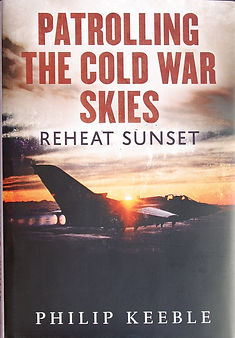Military Model Scene
Robin Buckland's
Patrolling the Cold War Skies...
...Reheat Sunset, new from Fonthill Media

Title: Patrolling the Cold War Skies
Author: Philip Keeble
Publisher: Fonthill Media
ISBN: 978-1-78155-596-5
Another fine aviation themed book from Fonthill Media which tells the story of the author's 28 year career in the RAF, starting in 1965 through to his retirement from the service in 1994. As he explains in his introduction, it is based around his three RAF Log Books which contain the factual details of dates, times, aircraft etc which if you read them by themselves would be factual but lacking colour. What he then does is tell the stories that wrap around those facts, bringing them to life for the reader. If you are looking for 'colour' then this is what you get. From the first story he tells, of one of his early solo training flights in a de Havilland Chipmunk, we get an immediate taste of his writing style and sense of humour. It got me smiling right from the off and grabbed my attention to read the rest.
So things start off in the mid-1960s and flying piston engine aircraft with Chipmunks and again later Bulldogs as a Flying Instructor at University Air Squadrons. He moved on to jets with the Jet Provost 3 and 5 before further training for fast jets with the Folland Gnat. From there he moved on to operational postings and that started with Canberras as he worked on photo reconnaissance duties. While other aircraft were flown along the way, such as the Jaguar and the Hawk, his two main fast jet types were the F4 Phantom and the F3 Tornado.
More amusing stories but mixed with serious lessons about flying as well, as experienced and explained by a well trained pilot. Sometimes boring routine (flying a Canberra largely using autopilot for navigator training), coping with potentially fatal aircraft faults (engine failure, fire warnings and suchlike, flying at night which was apparently not his favourite time for flying as well as some mischievous escapades which in some cases led to a 'ticking off'. His career took him to many different places around the world, and when on the Canberra recce squadron doing mapping tasks that would now be done using satellites. The author retired from the RAF in 1994 and even since then technology has moved forward but his stories of flying during the Cold War era makes for both in interesting read historically but an entertaining one at the same time. It is a book I can highly recommend as well worth reading. If I might quote a comment included in the book, put all these elements together, expanding on the simple notes in his Log Books, then 'Robert's your father's brother'.
Robin